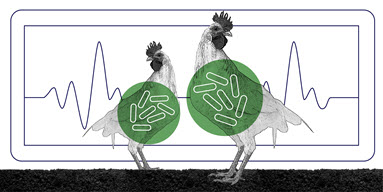Are you a sustainable animal producer? This checklist will let you know

Find out why responsible production starts at the microscopic level — and how to adapt best practices
When we picture sustainability, many people might think simply of acting in a way that doesn’t harm the environment. But there is a new, crucial factor to sustainability: the appropriate use of microbials. In some cases, animal producers are utilizing antibiotics appropriately, to treat illness. In other cases, antibiotics are used as a pre-emptive measure, or simply to boost growth. However, a regular flow of low antimicrobial doses can make the bacteria in animals resistant to drugs, leading to ineffective treatment, a spike in disease severity and plummeting productivity.
Worryingly, the scale of antimicrobial misuse is staggering. “In some countries,” the WHO says, “the total amount of antibiotics used in animals is four times larger than the amount used in humans.” And often, the antibiotics we use for our animals are used in human medicine, too. Now, when bacteria develop a resistance mechanism, it can quite easily transfer this resistance superpower to other bacteria. The result: more and more bacteria become resistant to antimicrobials, with some of those pathogens finding their way to people. To guard against this spreading resistance. sustainability will be key.
So what are the other dangers of antimicrobial misuse, particularly when animals are healthy and don’t require medication? And how can producers transition to a sustainable mindset in this space?
Here’s a quick checklist that might help.
1. Remember: what hurts your animal can hurt you, too
Careless use of antibiotics, as noted above, doesn’t just create antimicrobial resistance in animals. That resistance can spread through the physical environment and then pass to producers. This spread can be scarily fast. Interestingly, it’s a problem that has been recognized for a long time. As early as the 1960s, scientific reports noted how antimicrobial resistance could spread from animals to famers, then to the wider community.
2. Break big problems into small questions
Large-scale change can often seem impossible, if viewed as a single complex problem. The key is to break it down to manageable steps. Ask yourself: “What are my priorities? And what are my priority actions in this process of sustainable development?”
By outlining what matters to you, you can then move on to planning actions that best balance between what benefits your animals, helps the environment, and manages the investment costs required to kickstart your solution.
For smaller producers in particular, this process can be intimidating, particularly if you tackle it on your own.
Which leads us to a final key point in our checklist...
3. Don’t work alone
Success in this industry often comes down to one crucial quality: close collaboration between farmers, veterinarians, academics and governments. If true sustainability is to be achieved, all these stakeholders must be committed to tackling the issue.
It also helps to have a trusted provider who can keep you up to date on best practice of antimicrobial science. Because an effective solution for you might already exist — you just don’t know it yet.
That’s where Provimi’s teams come in to identify points of opportunity, from selecting high quality raw materials to precise nutrient formulation, supporting animal gut health and more. If you want to kickstart that conversation, feel free to get in touch.